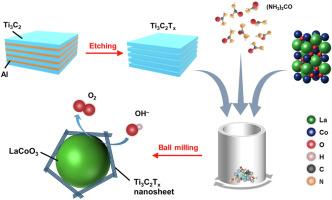Interfacial interplay in LaCoO3/Ti3C2Tx composites enables kinetic enhancement in electrochemical oxygen evolution
IF 8.3
2区 工程技术
Q1 CHEMISTRY, PHYSICAL
引用次数: 0
Abstract
Developing efficient electrocatalysts for the oxygen evolution reaction (OER) is crucial for sustainable hydrogen production via water electrolysis. Herein, we report the facile synthesis of single- or few-layer Ti3C2Tx MXene and LaCoO3/Ti3C2Tx composite catalysts by a ball milling-assisted exfoliation strategy with urea intercalation. Tafel slope plot was used to obtain the intrinsic Tafel slope of OER for LaCoO3/Ti3C2Tx composite with varying mass ratios. By optimizing the composite ratio, the intrinsic Tafel slope of OER is decreased from 88.6 to 47.1 mV/dec, indicating a shift of rate-determining step (RDS). This enhancement stems from interfacial electronic modulation rather than conductivity and hydrophilicity provided by Ti3C2Tx alone. Charge transfer between LaCoO3 and Ti3C2Tx elevated the Co valence state in LaCoO3 and induced lattice strain, which modulated its electronic structure and shifted the RDS of OER to O–O bond formation. This study highlights the interface engineering in composite catalysts for efficient energy conversion.

LaCoO3/Ti3C2Tx复合材料的界面相互作用使电化学析氧动力学增强
为析氧反应(OER)开发高效的电催化剂是水电解可持续制氢的关键。在此,我们报道了在尿素插层的球磨辅助剥离策略下,简单地合成了单层或多层Ti3C2Tx MXene和LaCoO3/Ti3C2Tx复合催化剂。采用Tafel斜率图得到了不同质量比LaCoO3/Ti3C2Tx复合材料OER的本特征Tafel斜率。通过优化复合比,OER的固有Tafel斜率从88.6减小到47.1 mV/dec,表明速率决定步长(RDS)发生了变化。这种增强源于界面电子调制,而不是Ti3C2Tx单独提供的导电性和亲水性。LaCoO3和Ti3C2Tx之间的电荷转移提高了LaCoO3中的Co价态,引起了晶格应变,从而改变了LaCoO3的电子结构,使OER的RDS转变为O-O键形成。本研究强调了复合催化剂中高效能量转化的界面工程。
本文章由计算机程序翻译,如有差异,请以英文原文为准。
求助全文
约1分钟内获得全文
求助全文
来源期刊

International Journal of Hydrogen Energy
工程技术-环境科学
CiteScore
13.50
自引率
25.00%
发文量
3502
审稿时长
60 days
期刊介绍:
The objective of the International Journal of Hydrogen Energy is to facilitate the exchange of new ideas, technological advancements, and research findings in the field of Hydrogen Energy among scientists and engineers worldwide. This journal showcases original research, both analytical and experimental, covering various aspects of Hydrogen Energy. These include production, storage, transmission, utilization, enabling technologies, environmental impact, economic considerations, and global perspectives on hydrogen and its carriers such as NH3, CH4, alcohols, etc.
The utilization aspect encompasses various methods such as thermochemical (combustion), photochemical, electrochemical (fuel cells), and nuclear conversion of hydrogen, hydrogen isotopes, and hydrogen carriers into thermal, mechanical, and electrical energies. The applications of these energies can be found in transportation (including aerospace), industrial, commercial, and residential sectors.
 求助内容:
求助内容: 应助结果提醒方式:
应助结果提醒方式:


